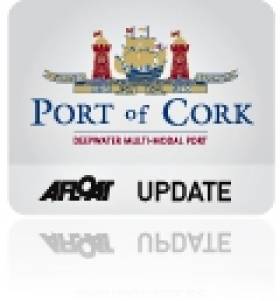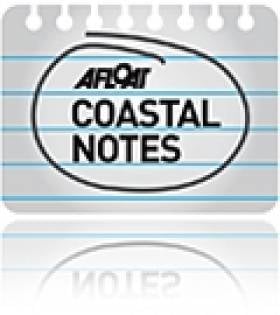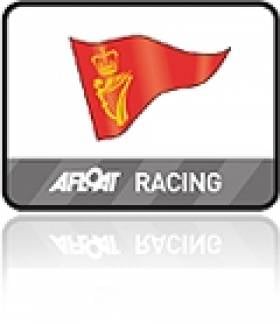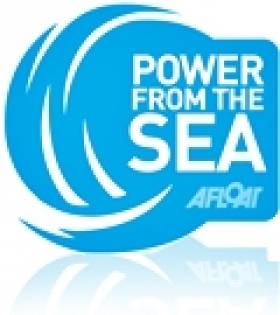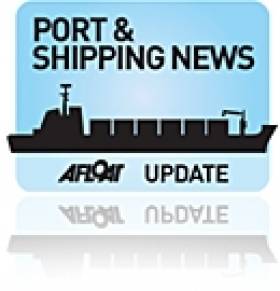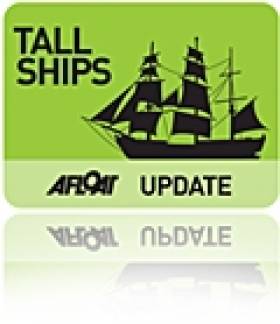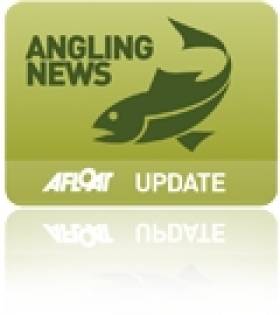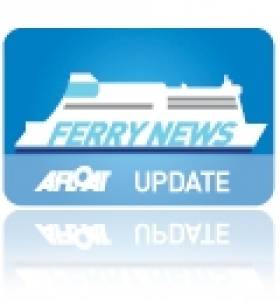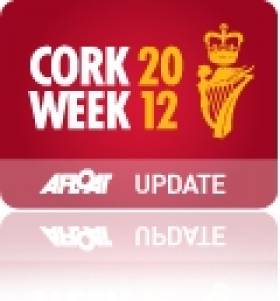Displaying items by tag: Cork
#PORTOFCORK – The Port of Cork today officially marked the expansion of the container handling facility at the Sean Lemass Deepwater Terminal, Ringaskiddy. These additional handling facilities have enabled the Port of Cork and global shipping company, Maersk to commence their first ever direct service to Ireland which now operates weekly, starting in the Mexican port of Vera Cruz and calling to Costa Rica, Belize and Panama before reaching Cork. This new service has enabled the Port of Cork to greatly increase efficiency both in imports and exports.
The Port of Cork has invested €2.9 million to bring this new service to fruition, with the investment in a new container compound and with the purchase of a new electric RTG (Rubber Tyred Gantry).
Port of Cork Chairman, Dermot O'Mahoney explained how this expansion is essential both for the port and for the local economy "The investment by the Port of Cork in this new facility demonstrates our commitment as a port to continue to grow the container business which in turn, provides a much needed stimulus in Ireland's import and export trade. Over the coming months, we will be embarking on new projects to continue to grow our facilities and to attract more services such as this into Cork.
"The vessels being used for this service are some of the largest of their type to be accommodated in the port, highlighting the deep-water capabilities of the port and the excellent facilities we have in place to handle such a service," he continued.
This new service sees a return of the banana trade with Fyffes to Cork which has not been seen in the port since the 1980s.
Oil Strike Success Off Cork Coast Could Be Worth Billions
#COASTAL NOTES - Providence Resources has struck big off the south coast of Cork with an oil flow that could be worth billions of euro to the beleaguered Irish economy.
According to the Guardian, the Dublin-based company announced yesterday that oil had started to flow successfully from its Barryroe structure in the north Celtic Sea at nearly twice the rate previously projected.
Providence Resources CEO Tony O'Reilly Jr said the discovery was a "seminal day for Ireland, especially in the runup to St Patrick's Day."
Last month the firm had confirmed the presence of light oil with its first appraisal well at the site, a situation described by its technical director as "extremely encouraging".
Now that a steady flow has been achieved, future extraction from the oil field - comparable to a medium-to-large North Sea field - can surely proceed, which now puts pressure on the Government to grand permission for further exploration around the Irish coast.
As previously reported on Afloat.ie, plans by Providence Rescources to prospect for oil on the east coast off Dalkey Island have been met with fierce opposition by mainland residents and environmental groups.
The Guardian has much more on the story HERE.
RCYC Hosts 'Moby Dick' Screening
#ROYAL CORK - It was "uncharted waters" for the Royal Cork Yacht Club in Crosshaven last night as it hosted its first ever film screening, a showing of the John Huston classic Moby Dick.
The epic adventure, starring Gregory Peck, was shot on location in nearby Youghal, and tells the story of the obsessed Captain Ahab's pursuit of the titular whale.
Joleen Cronin of the Crosshaven Film Club told the Irish Examiner: "There are lots of people throughout Cork who were involved in the making of the film and it’s a real celebration of movie making and special effects for its time."
The screening is hoped to be the first of many special events at the world's oldest yacht club, which will be hosting the biennial Cork Week regatta from 7-13 July.
Cork Company Set to Deploy Energy Device at Cornwall's Wave Hub
#POWER FROM THE SEA - An Irish firm has landed a contract to provide a wave device for a new offshore energy test site in Cornwall, Siliconrepublic reports.
Ocean Energy, which is based in Cork, will deploy its first full-scale wave energy device at Wave Hub - described as an 'electrical socket' for testing wave power technology - off Hayle in north Cornwall by the end of the year.
The technology behind the buoy-type device, which will cost €9 million, has been developed over the past three years via a quarter-scale prototype in Galway Bay.
Using the principle of the oscillating water column, the device works by channeling water through a submerged chamber that forces air through a turbine above the surface.
The full-scale unit is expected to generate enough electricity to power as many as 1,200 homes.
Siliconrepublic has more on the story HERE.
Body of Tit Bonhomme Skipper Recovered
#NEWS UPDATE - RTÉ News reports that a body found in Glandore Harbour today is that of Tit Bonhomme skipper Michael Hayes.
The body of the 52-year-old from Helvick Head in Co Waterford, who went missing more than three weeks ago, was discovered floating close to the mouth of the harbour around lunchtime by his brother, Garda Chief Spt Tom Hayes, according to The Irish Times.
As previously reported on Afloat.ie, the search operation in Glandore is being wound down this week after the remains of three of the five missing crew were recovered. Egyptian crewman Said Mohammed (23) - also known as Saied Ali Eldin - is still missing.
The fishing vessel Tit Bonhomme ran aground and went down in rough seas near Adam's Rock, at the mouth of Glandore Harbour, on Sunday 15 January.
Only one crewmember, 43-year-old Abdul Mohammed, is confirmed alive after he was able to reach the shore.
Swansea-Cork Ferry MV Julia For Sale
#SWANSEA CORK FERRY – The merchant ship MV Julia which operated as the Cork Swansea Ferry for the last two years is up for sale following the closure of The Fastnet Line ferry service and the loss of 78 jobs.
According to Dominic Daly Auctioneers the owners of the 1982–built vessel, a Finnish Bank, are inviting offers for the vessel on an 'AS SEEN AS IS' basis'. A guide price is expected shortly
As previously reported on Afloat.ie, the operator had been in examinership since last November, and a restructured business plan had been submitted with a view to resuming high-season service in April. However, in a statement the owners of the Fastnet Line said they had been unable to raise the €1m-plus investment required and that the examinership had "failed".
The ship is currently lying alongside at Cork Port.
The basic details of the vessel are as follows:
IMO Number: 8020642
Year of Build: 1982 (Germany)
Gross Tonnage: 22,161
DWT: 2,880
Net Tonnage: 8,921
LOA: 153.4
Length (BP): 136.02
Breadth: 24.24
Draught: 5.82
Height: 43.0
Displacement: 12,380
Passengers: Unberthed: 1,062
Cabins 344
Berths: 938
Crew: 110
Lorries: 110
Cars: 550
Ro-Ro Lanes: 710m x 5.20m 4.50m
Ramps: 1 Port 5.56 x 6.16 x 0
1 Starboard 5.56 x 6.16 x 0
1 Centre Or Only 9.95 x 6.68 x 0
Bow Door & Ramp, Stern Ramp
Sail Training Schooner Locked Up Since 2007
#TALL SHIPS - The flagship vessel for an Asgard-type sail training programme in Cork has been locked up in a boatyard since 2007, the Irish Examiner reports.
The Omar B was supposed to be the focus of a Youthreach project based in Bantry for early school leavers. But the schooner has spent the last four-plus years in storage in Baltimore, and has been deteriorating due to lack of maintenance - despite the scheme still notionally running, the newspaper report says.
Five two-man dinghies purchased with grant money have also reportedly spent most of 2011 in storage.
Co Cork's VEC has now put the €150,000 sailing programme under review following concerns over storage costs and lack of direction for the project.
The 75ft Omar B was donated to the CCVEC by owner and builder Don Attig in 2003 and refitted for use by students thanks to generous voluntary funding. Attig said the boat was of immense benefit to students who would not otherwise be in education.
The Irish Examiner has much more on the story HERE.
South Coast Hosts First Irish Bass Festival
#ANGLING - Ireland's south coast will play host to the first Irish Bass Festival this July.
Created and organised by Absolute Fishing, the lure angling event is open to all shore anglers at various venues between Tramore and Dungarvan in Co Waterford, which provide some of the best bass fishing in Europe.
The Irish Bass Festival will operate on catch-and-release rules, with anglers having to photograph their fish, using their own measuring board combined with a unique ID card provided by the organisers.
Competing anglers are also free to roam and fish anywhere along the coastline from Wexford to Cork - provided they're back in time to register their fish!
Details on requirements, reception and fishing times are available on the Irish Bass Festival website HERE.
Fastnet Line Closes For Good
#FERRY NEWS - The Fastnet Line ferry service between Cork and Swansea is to close with the loss of 78 jobs.
As previously reported on Afloat.ie, the operator had been in examinership since last November, and a restructured business plan had been submitted with a view to resuming high-season service in April.
However, in a statement the owners of the Fastnet Line said they had been unable to raise the €1m-plus investment required and that the examinership had "failed".
All 78 jobs will be lost as the company is set to be placed in receivership or liquidation later today.
The Fastnet Line - which was worth around €30 million to Cork in tourist spending - made its maiden voyage from Swansea to Cork in 2010, and was the only direct passenger and freight link between Wales and the south coast of Ireland.
The Irish Times has more on the story HERE.
Hong Kong, Holland and South Africa Entries Boost Cork Week
#CORK WEEK – South Africa's Tokoloshe, Holland's Tonnerre de Breskens, Hong Kong's Signal 8 and Ireland's own Ker 39 Antix will make up one of the most competitive class zero divisions for Cork Week in many years and the early news such an international line up is bound for Cork Harbour is a major advance for Crosshaven organisers, Royal Cork Yacht Club.
From Cape Town, South Africa Mike Bartholomew will be racing at Cork Week with his Mills 40, Tokoloshe. The sleek blue hull has been tremendously successful and was in fine form last year, winning the prestigious Britannia Cup at Cowes week. A previous winner of at the Scottish Series and RORC Easter Challenge, Tokoloshe has a fine racing pedigree and represented South Africa in the 2010 Rolex Commodores' Cup.
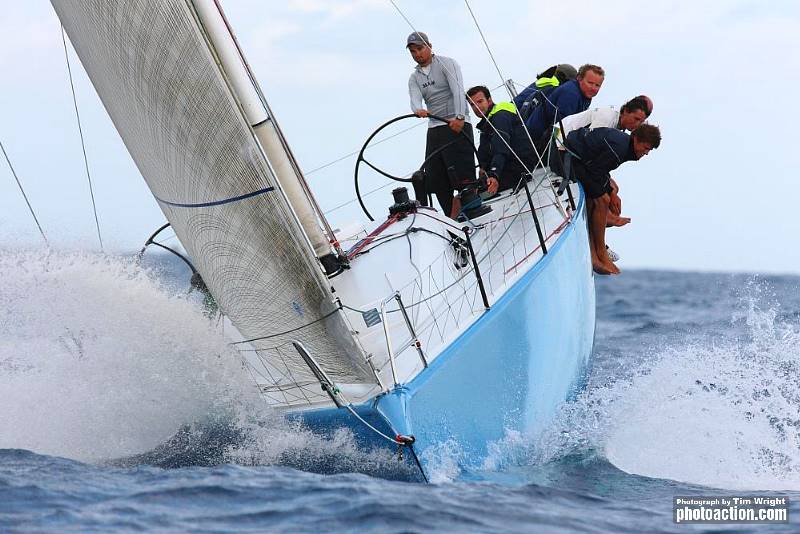
South Africa's Tokoloshe is heading for Cork Week in July
Mike Bartholomew explains why he is returning to Cork Week having missed the 2010 edition.
"At the start of the year, we planned out our season and Cork Week wasn't going to feature. However, we have changed our plans and will be in Crosshaven in July. The reason behind it is the relaxation of the rules about sailors classed as professionals. Tokoloshe is based in Hamble and most of the crew live in the village and work in the marine industry. None of them are paid to sail on Tokoloshe but because they are classed by ISAF as pros, this caused a major problem when entering Cork Week. I am delighted that the rules have been relaxed because we love coming to Cork Week, fantastic racing and a great atmosphere ashore, it really does tick all the boxes."
From Breskens, Holland Piet Vroon will be racing his Ker 46, Tonnerre de Breskens. 2010 RORC Yacht of the Year and Overall Round Ireland winner, Tonnerre has been one of the most successful yachts on the international racing circuit. Piet is now in his 80s and knows a thing or two about yacht racing. He has competed in 26 Fastnet Races, as skipper including last year's record-breaking race. Whilst Piet may well be one of the oldest competitors at Cork Week, his crew is composes of young aspiring sailors but none of them are paid to sail, that is Piet's way.
"I don't care much for the huge parties in the event village after racing but the boys love it. I prefer to relax in the evenings and get recharged for the next day's racing. The race management at Cork Week is first class and the variety of courses is excellent, one big advantage at Cork Week is that, besides the Harbour Course, there is very little tide, which means far better courses than say Cowes Week. I was introduced to Crosshaven by Dennis Doyle many years ago and I have been coming ever since."
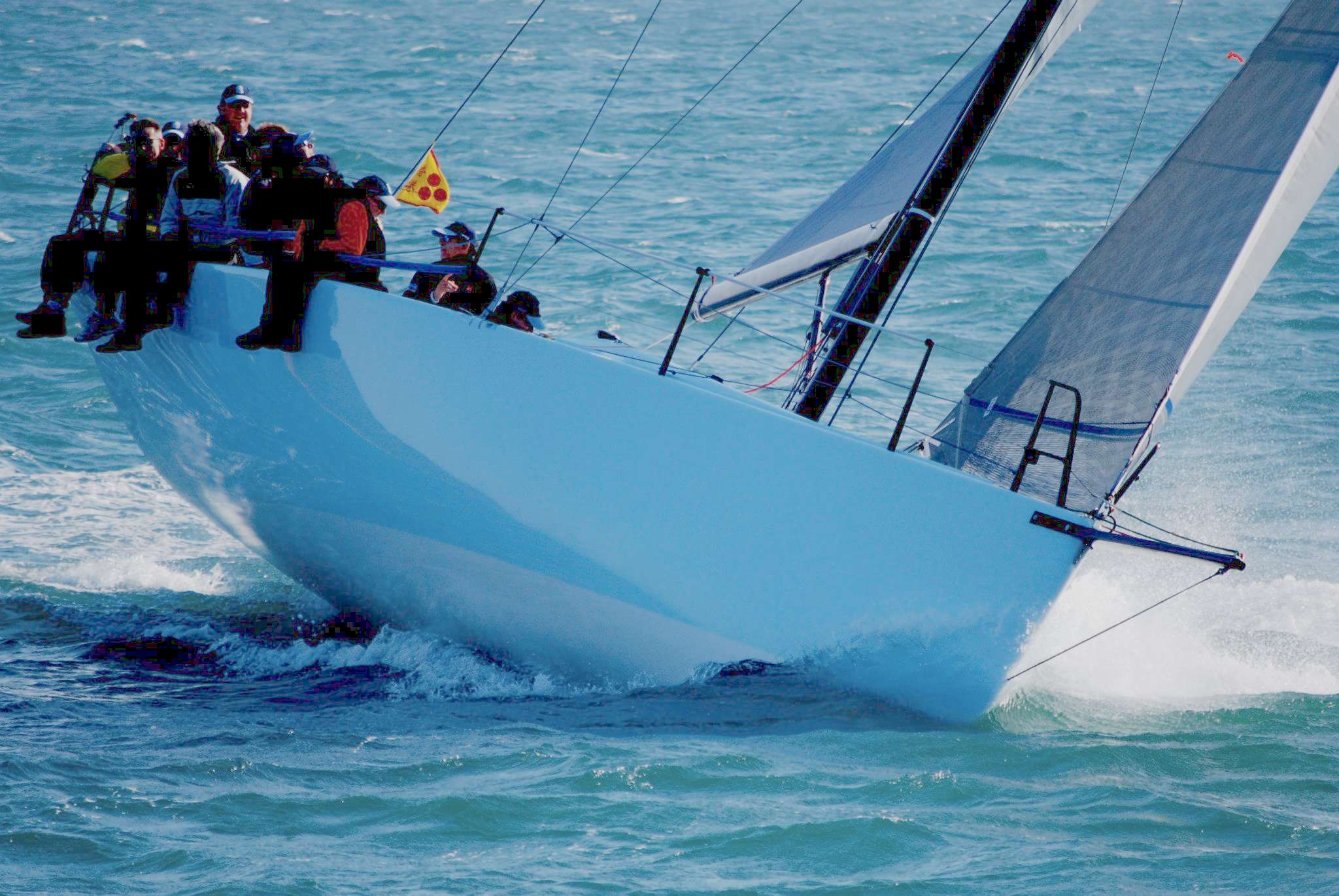
Jamie McWilliam returns from hong Kong with Signal 8
From Hong Kong, Cork Week will be welcoming back one of their son's Jamie McWilliam with his brand new Ker 40, Signal 8. The McWilliam family needs no introduction to Cork Week regulars. However, Jamie has lived in Hong Kong for many years and missed out in 2010.
"We plan to bring Signal 8 over to compete in the RORC IRC Nationals in June and we have an extensive programme throughout July with our sights firmly set on the Brewin Dolphin Commodores' Cup but Cork Week is most definitely a must.
The key ingredients to a successful regatta are great courses and excellent race management. There are other regattas that can match the superb range of courses at Cork Week but in my opinion, nobody does it better than Cork Week. If I was going to give competitors one good tip, it would be get some local knowledge on board. Back in 2000 on Swan 48 Jacobite, we were sailing towards the finish, rock hopping under Weaver's Point. Keith MacKeown was on board and his house was just yards from the finish line. Keith was lying on the foredeck with his head over the bow as we went in ducking the bricks, it made one hell of a difference to our result."
From Cape Town, South Africa Mike Bartholomew will be racing at Cork Week with his Mills 40, Tokoloshe. The sleek blue hull has been tremendously successful and was in fine form last year, winning the prestigious Britannia Cup at Cowes week. A previous winner of at the Scottish Series and RORC Easter Challenge, Tokoloshe has a fine racing pedigree and represented South Africa in the 2010 Rolex Commodores' Cup.
From Crosshaven, Ireland's Anthony O'Leary from the host club is delighted to be renewing old rivalries at the helm of his Ker 39, Antix.
"It is fantastic to hear that the South African King 40 Tokoloshe is coming to Cork Week and now that Jamie McWilliam will be bringing Signal 8 all the way from Hong Kong as well, it will make for a very competitive division. We three have been both sides of very close results in recent years and it is bound to be a real struggle on the water. Knowing Mike and Jamie, I am sure there will also be plenty of banter at the yacht club after racing!
To win at Cork Week, you have to race consistently well every day; the variety of courses evens out the design differences between the boats. I have no illusions, winning against good opposition is never easy but it makes racing at Cork Week all the more rewarding."




























